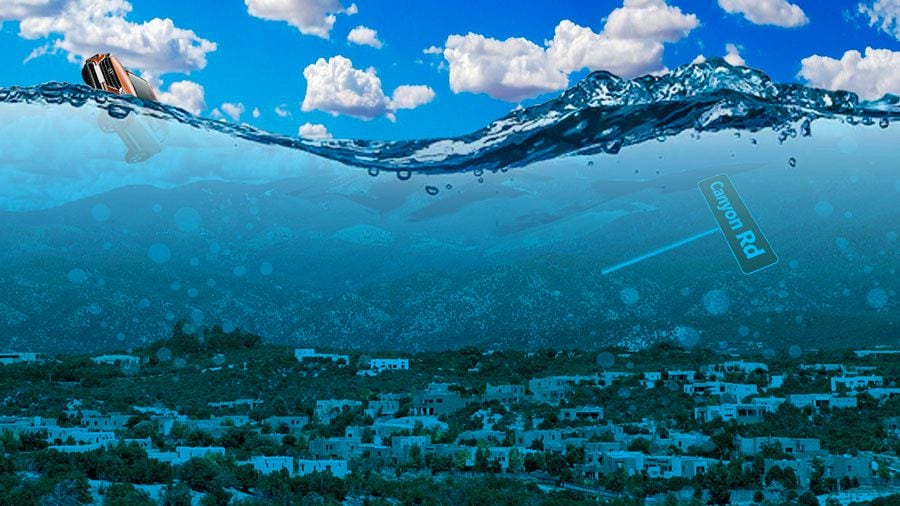The summer of 2021 has brought grim environmental news: Wildfires ravaging the West, megadroughts parching the landscape, record-shattering heatwaves.
By contrast, Santa Fe has good news about one of the city’s most discussed issues: water.
Officials painted a rosy picture of the city’s water resiliency, both in its current state and looking forward, in a recent update to City Council. Jesse Roach, the water division director, drew a line from 1995 until now to show the amount of progress the city has made nurturing water supplies.
The report comes in advance of an updated draft to the Source Water Protection Plan the city plans to unveil in September, which will include public comment. The plan, which assesses threats to the city’s water quality, builds off an older draft report first submitted by Daniel B. Stephens and Associates, Inc., to ensure Santa Fe’s drinking water continues to meet standards set by the federal Safe Drinking Water Act.
Andy Jochems, a source water specialist with the state Environment Department’s Drinking Water Bureau, explains that it’s easier and more cost effective to prevent contamination than to remediate polluted source water.
“That’s really the kind of impetus for a source water protection plan, a preventative proactive approach that outlines management strategy for a community’s source water,” Jochems tells SFR.
Jochems says the diversity of Santa Fe’s water sources makes the work interesting: The city’s water comes from multiple surface and groundwater sources—a point Roach also noted in his description of Santa Fe’s water resiliency.
“Not only do we not just have one supply, we have four supplies,” Roach told the City Council on July 28, referring to the Santa Fe River, Rio Grande, city wells and Buckman wells. In addition to the diversity of supply, Roach explains, water demand has decreased.
Since 1995, demand for water has dropped from 13,200 acre-feet per year to 8,800, a 33% decrease. That decline in consumption occurred in tandem with a 25% increase in Santa Fe’s population, from 68,000 about 25 years ago to 85,000 in 2020. Despite the exceptional drought hovering over Santa Fe, the city hasn’t needed to dig too deep into the wells to meet demands—80% of the water produced this year has come from surface water.
Roach attributes this to the city’s past efforts to expand options for water supplies and conservation efforts. And his department plans to continue strengthening Santa Fe’s resiliency through a number of different avenues.
One of those programs, the San Juan-Chama Return Flow Project, would treat effluent from the city’s wastewater facility and pump it back to the Rio Grande, at the Buckman Direct Diversion. Roach also plans to expand conservation in the commercial sector.
“We’re looking at potential aquifer storage and recovery within the city limits,” Roach told the City Council.
He explains infiltration ponds can capture precipitation for future use and “make it easier for us to lean on those wells.”
Roach remains confident in these strategies, but not overly so: “There’s no silver bullet, but maybe there’s bronze buckshot and I think that’s sort of what we have here.”
In light of Santa Fe’s positive supply outlook, Alan Hook, water resources coordinator with the city, says, “We’re gonna be in a new future.” He tells SFR the municipality is prepared for the influx of development and the demands it will place on water supplies.
For experts like Hook and Jochems, water quality must remain on the list of concerns.
“Santa Fe, like pretty much any urbanized area, has a pretty diverse array of potential contamination threats to source water,” says Jochems. Those threats stem from both natural and human sources.
The most pressing threats assessed in the report are the PNM Santa Fe Generating Station and wildfires in the municipal watershed. The plan outlines the threats and others, in addition to providing strategies to address issues specific to each risk.
The draft protection plan outlines 19 recommended actions to guide near- and long-term protection. The strategies range from bureaucratic: “The City should designate a Source Water Protection Team lead(s) or chair(s) to coordinate updates;” to actionable: “Continue wildfire mitigation efforts such as thinning and prescribed burning.”
One recommendation suggests that administrative “regulations and procedures should be developed as prescribed by...Safe Drinking Water and Source-Water Protection Ordinance.” The action refers to a 2005 ordinance the city adopted, prohibiting individuals from releasing pollutants into source water.
“Given that this source water protection plan laid out a more detailed analysis,” Hook explains, with this action, the city is “trying to align the old 2005 ordinance to maybe an update and an improvement.”
The Rio Grande surface water from the San Juan-Chama Project is not included in the Source Water Protection Plan because the Buckman Direct Diversion is a separate piece of infrastructure from the city and county water system—overseen by a hybrid board of City Council members, county commissioners and a citizen representative.
“The real challenge with the Rio Grande, which the city of Santa Fe really didn’t have with its various water supply sources, was how far upstream to go,” Kyle Harwood, an attorney who specializes in water issues, tells SFR. Harwood has served as general counsel of the Buckman Direct Diversion since 2008.
An older plan only looked at potential contamination sources within 20 miles of the intake, which critics stated is not far enough upstream for adequate protection. Efforts to expand the conservation plan will resume—after stalling during the pandemic—in the coming months, says Harwood.

